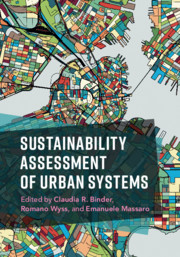Book contents
- Sustainability Assessment of Urban Systems
- Sustainability Assessment of Urban Systems
- Copyright page
- Contents
- Preface
- Acknowledgments
- Contributors
- General Introduction
- Part I Theoretical Background
- 1 Sustainability Assessment: Introduction and Framework
- 2 Systems Science and Sustainability Assessment
- 3 How Values Play into Sustainability Assessments: Challenges and a Possible Way Forward
- 4 The Politics of Participatory Sustainability Assessments: An Analysis of Power
- 5 A Concept for Sustainability Transition Assessment (STA): A Dynamic Systems Perspective Informed by Resilience Thinking
- Part II Integrative Approaches for Sustainability Assessment
- Part III Perspectives on Urban Sustainability
- Part IV Focal Points of Urban Sustainability
- Index
- References
5 - A Concept for Sustainability Transition Assessment (STA): A Dynamic Systems Perspective Informed by Resilience Thinking
from Part I - Theoretical Background
Published online by Cambridge University Press: 27 March 2020
- Sustainability Assessment of Urban Systems
- Sustainability Assessment of Urban Systems
- Copyright page
- Contents
- Preface
- Acknowledgments
- Contributors
- General Introduction
- Part I Theoretical Background
- 1 Sustainability Assessment: Introduction and Framework
- 2 Systems Science and Sustainability Assessment
- 3 How Values Play into Sustainability Assessments: Challenges and a Possible Way Forward
- 4 The Politics of Participatory Sustainability Assessments: An Analysis of Power
- 5 A Concept for Sustainability Transition Assessment (STA): A Dynamic Systems Perspective Informed by Resilience Thinking
- Part II Integrative Approaches for Sustainability Assessment
- Part III Perspectives on Urban Sustainability
- Part IV Focal Points of Urban Sustainability
- Index
- References
Summary
Sustainability as a key principle that guides the development of our societies requires fundamental transitions if we are to attain a more liveable planet. Concomitantly, the question of how to assess sustainability not only with respect to specific system states, but also regarding transition processes as a whole, has gained greater importance. In this chapter, we propose to extend established sustainability assessment practices with an approach informed by resilience thinking. In particular, we apply a systemic angle to develop three analytical perspectives which focus on the progress, the stability, as well as the adaptability of transition processes. These perspectives make it possible to reflect on the history, current state, and (potential) future development of the system in transition. We illustrate how these analytical perspectives can complement existing sustainability assessment approaches with regard to the description, interpretation, and evaluation of the transition process.
- Type
- Chapter
- Information
- Sustainability Assessment of Urban Systems , pp. 123 - 138Publisher: Cambridge University PressPrint publication year: 2020



